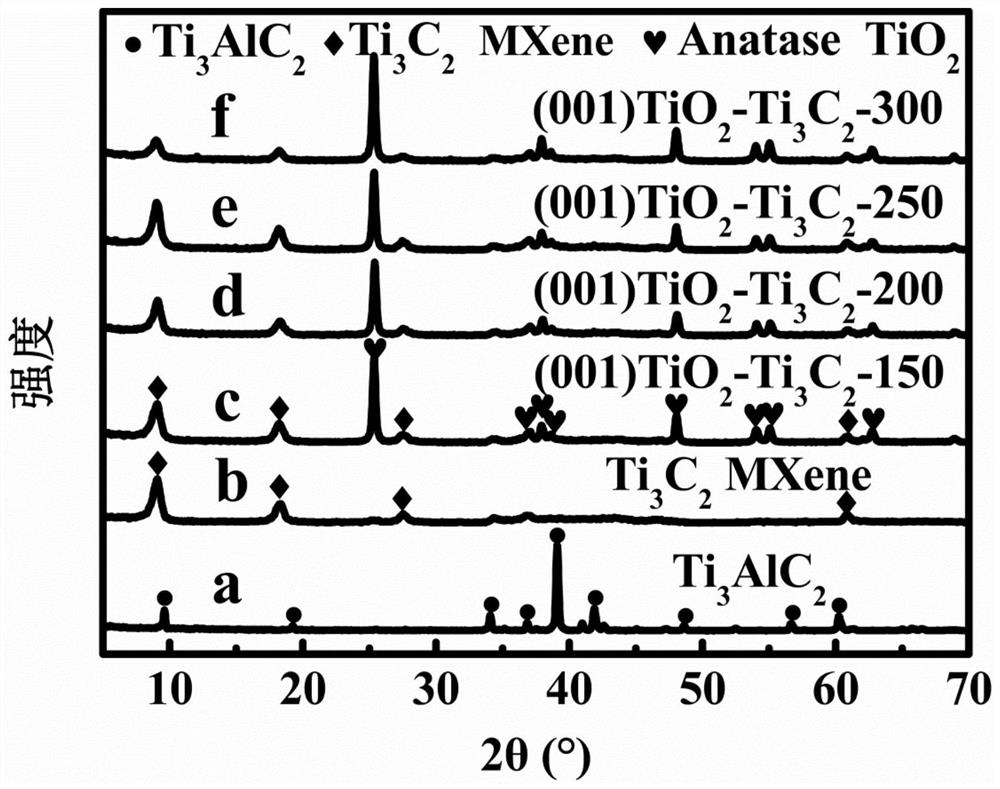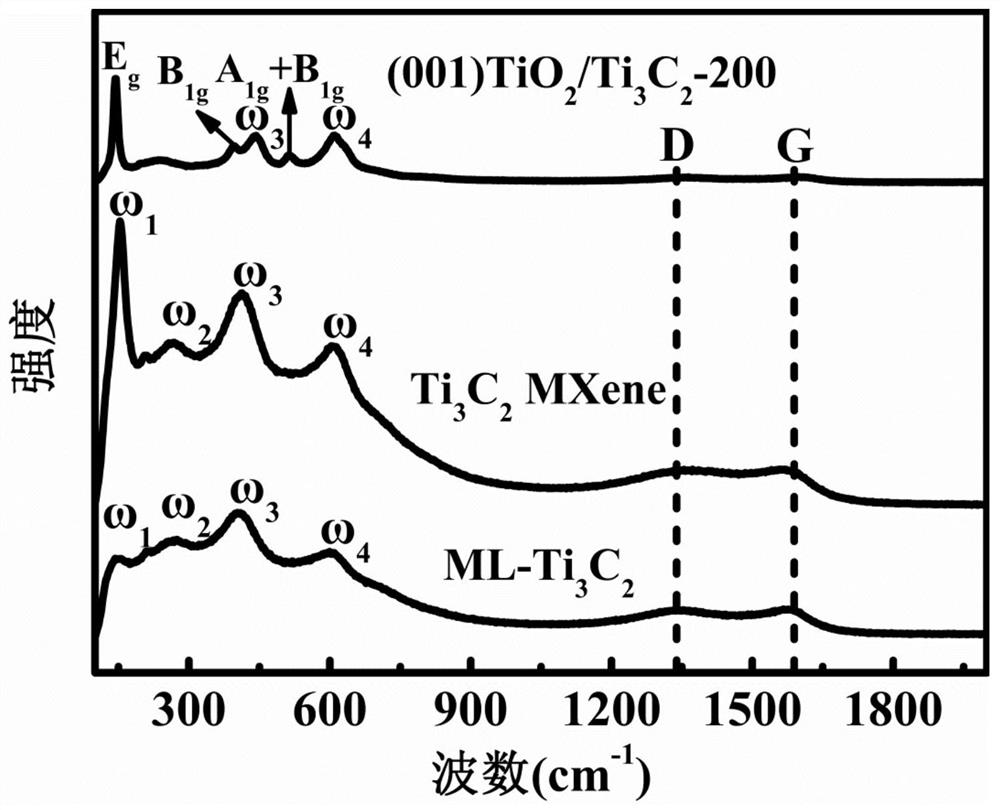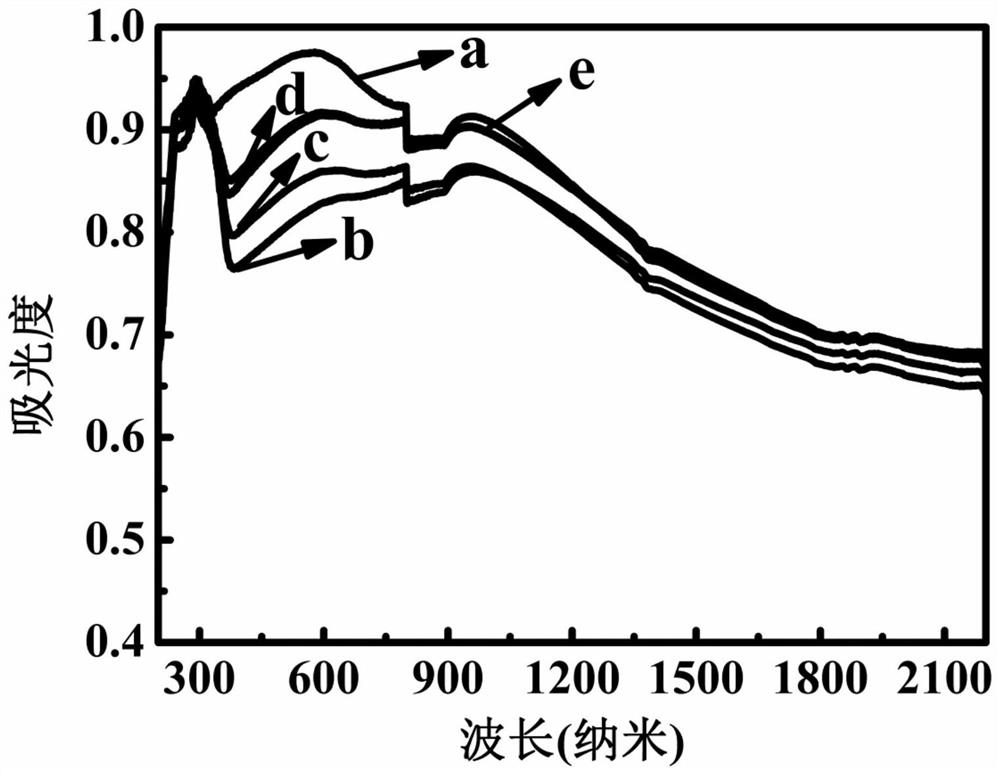Exposed (001) crystal face titanium dioxide/titanium carbide nanosheet as well as preparation method and application thereof
A technology of titanium dioxide and titanium carbide, applied in chemical instruments and methods, chemical/physical processes, physical/chemical process catalysts, etc., can solve the problems of application limitations, weak photocatalytic performance, etc., achieve excellent conductivity and improve separation efficiency Effect
- Summary
- Abstract
- Description
- Claims
- Application Information
AI Technical Summary
Problems solved by technology
Method used
Image
Examples
Embodiment 1
[0047] Step 1: Add MAX phase ceramic powder Ti 3 AlC 2 Add it into the HF solution at a concentration of 0.1g / mL, stir at room temperature for 27 hours to obtain a reaction solution, wash the reaction solution with deionized water and ethanol to a pH of 6, and then vacuum dry it at 60°C for 12 hours to obtain ML-Ti 3 C 2 Powder;
[0048] Step 2: Take 1g ML-Ti 3 C 2 Disperse in 40mL deionized water, ultrasonically break at room temperature for 100min, and the ultrasonic power is 70W, to obtain Ti 3 C 2 MXene solution, the Ti 3 C 2 The MXene solution was collected by centrifugation and dried under vacuum at 60 °C for 12 h to obtain Ti 3 C 2 MXene.
[0049] Step 3, take 150mgTi 3 C 2 Add MXene to 30mL HCl solution with a concentration of 1mol / L, and add 0.33gNaBF at the same time 4 As a crystal surface control agent, stir for 30 minutes, ultrasonic for 10 minutes, then transfer to a polytetrachlorethylene hydrothermal reaction kettle for hydrothermal reaction at ...
Embodiment 2
[0051] Step 1: Add MAX phase ceramic powder Ti 3 AlC 2 Add HF solution at a concentration of 0.1 g / mL, stir at room temperature for 27 hours to obtain a reaction solution, centrifuge the reaction solution with deionized water and ethanol to pH 7, and then vacuum-dry it at 60°C for 12 hours to obtain ML-Ti 3 C 2 ;
[0052] Step 2: Take 1g ML-Ti 3 C 2 Disperse in 40mL deionized water, ultrasonically break at room temperature for 100min, and the ultrasonic power is 70W, to obtain Ti 3 C 2 MXene solution, the Ti 3 C 2 The MXene solution was collected by centrifugation and dried under vacuum at 60 °C for 12 h to obtain Ti 3 C 2 MXene.
[0053] Step 3, take 200mgTi 3 C 2 Add MXene to 30mL HCl solution with a concentration of 1mol / L, and add 0.33gNaBF at the same time 4 As a crystal surface control agent, stir for 30 minutes, ultrasonic for 10 minutes, then transfer to a polytetrachlorethylene hydrothermal reaction kettle for hydrothermal reaction at 160°C for 12 hou...
Embodiment 3
[0055] Step 1: Add MAX phase ceramic powder Ti 3 AlC 2 Add it into the HF solution at a concentration of 0.1g / mL, stir at room temperature for 27 hours to obtain a reaction solution, wash the reaction solution with deionized water and ethanol to a pH of 6, and then vacuum dry it at 60°C for 12 hours to obtain ML-Ti 3 C 2 ;
[0056] Step 2: Take 1g ML-Ti 3 C 2 Disperse in 40mL deionized water, ultrasonically break at room temperature for 100min, and the ultrasonic power is 70W, to obtain Ti 3 C 2 MXene solution, the Ti 3 C 2 The MXene solution was collected by centrifugation and dried under vacuum at 60 °C for 12 h to obtain Ti 3 C 2 MXene.
[0057] Step 3, take 250mgTi 3 C 2 Add MXene to 30mL HCl solution with a concentration of 1mol / L, and add 0.33gNaBF at the same time 4 As a crystal surface control agent, stir for 30 minutes, ultrasonic for 10 minutes, then transfer to a polytetrachlorethylene hydrothermal reaction kettle for hydrothermal reaction at 160°C ...
PUM
 Login to View More
Login to View More Abstract
Description
Claims
Application Information
 Login to View More
Login to View More - R&D
- Intellectual Property
- Life Sciences
- Materials
- Tech Scout
- Unparalleled Data Quality
- Higher Quality Content
- 60% Fewer Hallucinations
Browse by: Latest US Patents, China's latest patents, Technical Efficacy Thesaurus, Application Domain, Technology Topic, Popular Technical Reports.
© 2025 PatSnap. All rights reserved.Legal|Privacy policy|Modern Slavery Act Transparency Statement|Sitemap|About US| Contact US: help@patsnap.com



